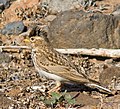| Alaudala | |
|---|---|
 | |
| Mediterranean short-toed lark (Alaudala rufescens) | |
| Scientific classification | |
| Kingdom: | Animalia |
| Phylum: | Chordata |
| Class: | Aves |
| Order: | Passeriformes |
| Family: | Alaudidae |
| Genus: | Alaudala Horsfield & Moore, F, 1858 |
| Type species | |
| Alauda raytal [1] Blyth, 1844 | |
| Species | |
see text | |
Alaudala is a genus of lark in the family Alaudidae. The genus name is a diminutive of Alauda . [2]




